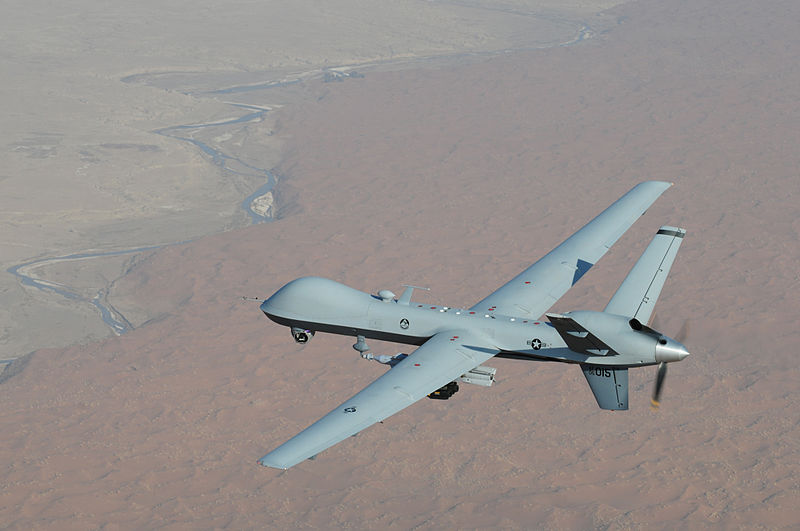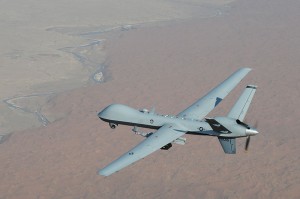
The US and its UAVs: A Cost-Benefit Analysis
 A significant factor in the US Government’s expansion of its drone programs is the cost advantage the technology holds over more conventional military equipment, forces, and operations. While drones are unmanned, their operation still requires a ground flight crew, maintenance crew, and extensive networks of systems and people to provide the intelligence used and legal authorization to conduct lethal strikes. Opponents of US drone programs, taking into account this requisite human support as well as a significantly higher mishap rate, assert that drones are more expensive to operate, and the backlash caused by their use threatens to be even more costly to the US in the long-term.
A significant factor in the US Government’s expansion of its drone programs is the cost advantage the technology holds over more conventional military equipment, forces, and operations. While drones are unmanned, their operation still requires a ground flight crew, maintenance crew, and extensive networks of systems and people to provide the intelligence used and legal authorization to conduct lethal strikes. Opponents of US drone programs, taking into account this requisite human support as well as a significantly higher mishap rate, assert that drones are more expensive to operate, and the backlash caused by their use threatens to be even more costly to the US in the long-term.
From a high-level examination, drones are slightly more cost effective to acquire and operate than conventional manned aircraft. The question of cost effectiveness should instead be one of operational advantage: whether the strategic advantage and human protection afforded by the use of drones in overseas operations outweighs the potential security threat posed by higher crash rates and growing backlash in target environments.
A quick comparison of basic unit and operating costs compiled from unclassified Department of Defense Selected Acquisition Reports indicate that, with the exception of the RQ-4 Global Hawk, drones are generally cheaper to acquire and operate than conventional fighter jets.
|
Unit per SAR |
APUC Cost per Unit ($mm)[1] |
Cost per Aircraft ($mm)[2] |
O&S Avg Annual Cost/Aircraft ($K)[3] |
O&S Avg Annual Cost per Flying Hour/Aircraft ($K)[4] |
Base Year[5] |
|
| UAS | ||||||
|
MQ-1 Predator |
4 aircraft |
1,210.0[6] |
1.32 |
2010 |
||
|
4 aircraft, associated equip/payloads |
106.49 |
26.62 |
7,960.0 |
— |
2010 |
|
|
4 aircraft, associated equip./personnel |
25.93 |
6.48 |
2,988.0 |
3.25 |
2008 |
|
|
1 aircraft, associated equip./payloads |
103.04 |
103.04 |
15,591.10 |
31.12 |
2000 |
|
| Conv. Aircraft | ||||||
|
F-15C |
1 aircraft |
N/A | N/A |
7,681.11[7] |
25.69 |
N/A |
|
F-16C/D |
1 aircraft |
N/A | N/A |
4,039.80[8] |
13.47 |
N/A |
|
1 aircraft |
185.73 |
185.73 |
11,255.56[9] |
11.26 |
2005 |
|
|
1 aircraft |
90.77 |
90.77 |
4,927.50[10] |
16.43 |
2002 |
(Data is for DoD assets for use in overt missions only. Data current as of December 2011 except for F-15 and F-22 SARs,which are current as of December 2010. Please refer to endnotes for an explanation of measurements and values.)
It should be noted that F-15s and F-16s are no longer in acquisition; therefore, the per-unit cost is irrelevant in comparisons to those of various UAS. Operating and support costs, however, do remain relevant as these two aircraft are the preeminent strikers used in combat zones at this time.
In regards to personnel requirements, conventional fighter jets on average require only one pilot. Drones, conversely, average flight crews of at least two: one pilot and at minimum, one sensor operator. It is estimated that a total of 82 personnel is required to operate one Predator CAP from beginning to end.
Drones do have a greater tendency toward “mishaps,” the preferred term for crashes. A report from the Congressional Budget Office states that despite beginning with a mishap rate of 28 mishaps per 100,000 flight hours, Predator drone technology and pilot training has improved such that Predator mishap rates hover around 7.6 per 100,000 flight hours, still far about the 2.36 rate of F-15s in 2011. USAF has compiled a very thorough accounting of its aircraft lost in overt missions. For the USAF, total monetary losses from 2011’s 12 Predator crashes – approximately $48 million in total and mostly occurring overseas – still come in below the approximate $57.3 million-plus in losses from five F-16 mishaps that same year, most of which occurred domestically.
While monetary losses from drone crashes may be of little consequence in the big picture, security concerns are paramount. As the 2011 crash of an RQ-170 Sentinel in Iran demonstrated, drone crashes risk compromising missions and security should the enemy get a hold of the technology and either reverse engineer or offer it for sale to other hostile actors.
Admittedly, there are unknowns and variations in any cost evaluation of US military technology, but it appears that the drones most widely used in US operations have a slight cost advantage over fighter jets. However, the strategic advantages secured by this technology’s use should be evaluated in equal measure. While manned fighter jets have bigger and stronger powerplants, are faster, more maneuverable, and more versatile in their mission assignments, drones offer several strategic advantages manned aircraft are unable to provide.
By virtue of their unmanned operation, drones can be sent into hostile areas with no risk to the lives of pilots; loiter for hours, unconstrained by shift schedules or human endurance; conduct more surveillance and collect more intelligence than humans are able to analyze (a problem unto itself); and, when required, execute a targeted strike with precision. It is difficult to value these strategic advantages, and even more so to evaluate the negative backlash arising from US drone operations. There is a considerable lack of agreed-upon and objective metrics by which to measure strategic advantages and potential drawbacks to the US’ use of drones where it may previously have called upon conventional aircraft. It is these areas of concern where data is most lacking and in which additional scrutiny is most needed.
[1] APUC is the Average Procurement Unit Cost, denoted in millions of dollars.
[2] Cost per Aircraft is the APUC divided by the number of aircraft (if multiple) comprising one unit, denoted in millions of dollars.
[3] O&S Average Annual Cost per Aircraft is the cost of Operations and Support per Unit, including “Unit-level Manpower, Unit Operations, Maintenance, Sustaining Support, Continuing System Improvements, Indirect Support, and Other,” denoted here in thousands of dollars and adjusted to reflect costs on a per-aircraft basis.
[4] O&S per Aircraft is the preceding value divided by the number of aircraft (if multiple) comprising one unit, denoted in thousands of dollars.
[5] Base year is the initial year in which acquisition was valued. Variations due to different cost base years should be taken into consideration.
[6] Cost obtained from the MQ-9 Reaper SAR. The MQ-1 Predator is antecedent to the MQ-9 Reaper.
[7] Cost obtained from F-22 SAR, updated to base year 2010, and is provided per squadron of 18 aircraft. This value represents the per-aircraft cost, obtained by dividing the total annual cost per squadron of $141.5 million by 18 aircraft, denoted in thousands of dollars.
[8] Cost obtained from the F-35 SAR. The F-16C/D is antecedent to the F-35.
[9] Cost is provided per squadron of 18 aircraft. This value represents the per-aircraft cost, obtained by dividing the total annual cost per squadron of $202.6 million by 18 aircraft, denoted in thousands of dollars.
[10] Cost calculated based on estimated average of 300 flight hours per year, denoted in thousands of dollars.






[…] the discourse on drones is the cost-benefit tradeoff in their acquisition and use. While ASP’s analysis indicates that drones, in general, are slightly more cost effective to acquire and operate than […]
[…] From a high-level examination, drones are slightly more cost effective to acquire and operate than conventional manned aerial vehicles. […]
[…] of the cost of an F-22, the Air Force’s most advanced war plane, is 10 times that amount. An analysis by the American Security Project concluded that, even after accounting for the dozens of personnel […]
[…] why drones will continue to be a part of U.S. security strategy cited ASP’s cost-benefit analysis of the U.S. drone program. The article was released in the wake of President Obama’s recent […]
[…] basic principals are visible in the emergence of drones. For example, according to the American Security Project, unclassified reports show that the MQ-9 Reaper drone used for attacks in Pakistan has a single […]
Given carte blanche, how would you improve upon the A-10 Thunderbolt II “Warthog?”
As always, lots of great stuff from folks like Tom Farrier – so I’ll add just a few thoughts. One of the mistakes I’ve seen with books and movies that copy blockbuster successes is that they try to imitate the wrong things. When a runaway hit happens…
[…] The US and its UAVs: A Cost-Benefit Analysis … – Cost obtained from F-22 SAR, updated to base year 2010, and is provided per squadron of 18 aircraft. This value represents the per-aircraft cost, obtained by dividing the total annual cost per squadron of $141.5 million by 18 aircraft, denoted in thousands of dollars. […]
[…] The US and its UAVs: A Cost-Benefit Analysis … – O&S Average Annual Cost per Aircraft is the cost of Operations and Support per Unit, including “Unit-level Manpower, Unit Operations, Maintenance, Sustaining Support, Continuing System Improvements, Indirect Support, and Other,” denoted here in thousands of dollars and adjusted to reflect costs … […]
[…] The US and its UAVs: A Cost-Benefit Analysis … – The US and its UAVs: A Cost-Benefit Analysis … – Cost obtained from F-22 SAR, updated to base year 2010, and is provided per squadron of 18 aircraft. This value represents the per-aircraft cost, obtained by dividing the total annual cost per squadron of $141.5 million by … […]
[…] The US and its UAVs: A Cost-Benefit Analysis … – The US and its UAVs: A Cost-Benefit Analysis … – Cost obtained from F-22 SAR, updated to base year 2010, and is provided per squadron of 18 aircraft. This value represents the per-aircraft cost, obtained by dividing the total annual cost per squadron of $141.5 million by … […]